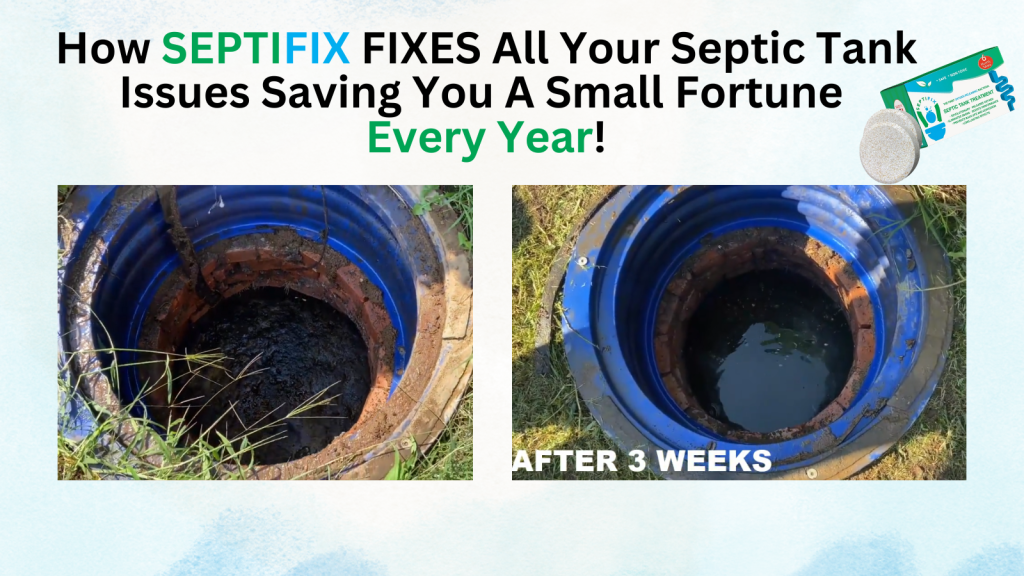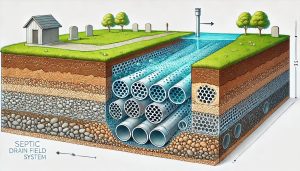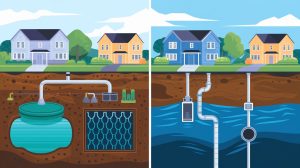Aerobic Treatment Units (ATUs) are advanced septic systems that use oxygen to treat wastewater efficiently. Unlike traditional septic systems, ATUs produce cleaner effluent, making them ideal for environmentally sensitive areas. With growing concerns about groundwater contamination and strict environmental regulations, ATUs have emerged as a reliable solution for many homeowners. This article explains how ATUs work, their advantages, costs, and maintenance requirements, and why they are sometimes the better choice compared to conventional systems.
Table of Contents
- How Aerobic Treatment Units (ATUs) Work
- Key Differences Between ATUs and Traditional Systems
- Benefits of Aerobic Treatment Units
- Maintenance Requirements
- Costs of ATUs
- When to Choose an ATU
- FAQs About Aerobic Treatment Units
- Septifix
- Septic Permit Links by State
How Aerobic Treatment Units (ATUs) Work
ATUs operate differently from traditional anaerobic septic systems by incorporating oxygen into the treatment process. Oxygen promotes the growth of aerobic bacteria, which break down waste more effectively and efficiently. Here is a step-by-step explanation of how ATUs work:
- Pre-Treatment: Solids settle in the pre-treatment chamber, similar to the septic tank in traditional systems. Larger particles and debris sink to the bottom, where they begin to break down.
- Aeration: Oxygen is pumped into the aeration chamber using an air blower or compressor. The oxygen-rich environment supports aerobic bacteria that feed on organic waste, breaking it down into smaller particles. This process is significantly faster and more thorough than anaerobic decomposition.
- Clarification: After aeration, the treated water flows into a clarification chamber. Any remaining solids settle to the bottom, while the cleaner effluent rises to the top and exits the unit.
- Optional Disinfection: Depending on local regulations, the effluent may undergo additional disinfection, such as UV treatment or chlorination, to ensure the highest level of cleanliness before being discharged.
The result is cleaner, safer wastewater that poses a lower risk to the environment and groundwater.
Key Differences Between ATUs and Traditional Systems
While both systems are designed to manage household wastewater, ATUs differ from traditional anaerobic septic systems in several key ways:
1. Treatment Process
- ATUs: Use oxygen to support aerobic bacteria, which break down waste quickly and efficiently.
- Traditional Systems: Rely on anaerobic bacteria that operate without oxygen, resulting in slower decomposition.
2. Effluent Quality
- ATUs: Produce cleaner, higher-quality effluent that requires less soil filtration.
- Traditional Systems: Effluent may still contain higher levels of contaminants, relying on soil to filter out pollutants.
3. Design and Space Requirements
- ATUs: Compact and versatile, making them ideal for smaller properties or locations with poor soil quality.
- Traditional Systems: Require larger drain fields for filtration, limiting their use in areas with space constraints.
4. Environmental Impact
- ATUs: Reduce groundwater contamination and meet stricter environmental standards.
- Traditional Systems: Pose a greater risk of leaching pollutants into groundwater, especially if the system fails or the soil is inadequate for filtration.
5. Cost
- ATUs: Higher upfront installation costs and regular maintenance expenses.
- Traditional Systems: Lower initial costs but may require costly replacements or upgrades over time.
Benefits of Aerobic Treatment Units
Investing in an ATU offers several advantages, particularly for homeowners facing environmental or property-related challenges:
1. Cleaner Effluent
ATUs produce high-quality, treated effluent that is much cleaner than what traditional systems generate. This makes them ideal for environmentally sensitive areas, such as properties near lakes, rivers, or wetlands.
2. Space Efficiency
Because ATUs do not rely heavily on soil filtration, they require smaller drain fields or leach areas. This is particularly beneficial for:
- Small lot sizes
- Properties with poor soil conditions
- Urban or suburban areas where space is limited
3. Environmentally Friendly
ATUs help protect local ecosystems and groundwater from contamination. They are often required in areas where environmental standards are stricter, reducing the risk of pollution from untreated wastewater.
4. Improved Performance
Compared to traditional systems, ATUs perform well under a variety of conditions, including:
- High water tables
- Rocky or clay-heavy soil
- Cold climates where anaerobic systems struggle to function effectively
5. Long-Term Reliability
With proper maintenance, ATUs can have a longer lifespan than traditional systems. Their advanced treatment process reduces the likelihood of system failure.
Maintenance Requirements
To keep ATUs operating efficiently, regular maintenance is essential. Unlike traditional septic systems, which may only need periodic pumping, ATUs involve additional components that require ongoing care:
1. Regular Inspections
Homeowners should schedule inspections every 3-6 months. During these inspections, technicians check the following:
- Air pumps and blowers
- Aeration chambers
- Filters and alarms
2. Pumping
Like traditional systems, ATUs need solids removed periodically. Pumping is recommended every 1-3 years, depending on usage and tank size.
3. Component Care
ATUs include mechanical and electrical parts, such as air pumps and diffusers. These components must be serviced and replaced as needed to ensure the system functions properly.
4. Filter Cleaning
Filters in ATUs prevent solids from leaving the system. These filters need to be cleaned regularly to avoid clogging and ensure smooth operation.
Proper maintenance is critical for preventing breakdowns and prolonging the lifespan of the system. Neglecting maintenance can lead to costly repairs or system failures.
Costs of ATUs
While ATUs provide advanced treatment and environmental benefits, they come with higher costs compared to traditional systems:
1. Installation Costs
The average cost to install an ATU ranges from $7,000 to $15,000, depending on system size, location, and local regulations. Additional costs may arise if a disinfection system or advanced components are required.
2. Maintenance Costs
Annual maintenance for an ATU typically costs between $200 and $500. This includes inspections, servicing of mechanical parts, and occasional filter cleaning. Homeowners should also budget for potential repairs to air pumps or other components.
While ATUs require a larger upfront investment, their efficiency and environmental benefits often justify the cost, especially in areas with strict wastewater management requirements.
When to Choose an ATU
Aerobic Treatment Units are the ideal solution for specific circumstances where traditional systems fall short. Consider installing an ATU if:
- You have limited space: Compact ATUs are suitable for small properties.
- Soil conditions are poor: ATUs work effectively in areas with clay, rocky, or sandy soil.
- Groundwater is high: Traditional systems can fail in areas with elevated water tables.
- Environmental regulations are strict: ATUs meet higher treatment standards, reducing contamination risks.
- You live near water bodies: Cleaner effluent helps protect lakes, rivers, and wetlands.
Conclusion
Aerobic Treatment Units (ATUs) offer advanced wastewater treatment, outperforming traditional septic systems with cleaner, safer effluent. Their compact design, environmental benefits, and versatility make them ideal for challenging properties and environmentally sensitive areas. While ATUs come with higher installation and maintenance costs, their long-term performance and reliability provide significant value.
If you’re considering upgrading to an ATU, consult a septic professional to determine if it’s the right solution for your property. Explore our resources to learn more about advanced septic systems and maintenance tips.
FAQs About Aerobic Treatment Units
Do ATUs require electricity?
Yes, ATUs depend on electrical components such as air pumps and blowers to function effectively. This reliance on electricity is a key aspect of their operation, enabling the aeration process that supports aerobic bacteria growth.
What is the main difference between ATUs and traditional septic systems?
Aerobic Treatment Units (ATUs) utilize aerobic bacteria that require oxygen to treat wastewater, resulting in cleaner effluent. In contrast, traditional septic systems rely on anaerobic bacteria and soil filtration, which are less efficient in breaking down organic matter.
How much does an Aerobic Treatment Unit cost?
The installation costs for ATUs typically range from $7,000 to $15,000, depending on the system’s complexity and site conditions. Annual maintenance expenses can vary between $200 and $500, with potential additional costs for electricity and repairs.
How often do ATUs need to be serviced?
ATUs generally require inspections every 3 to 6 months and pumping every 1 to 3 years, depending on usage patterns and local regulations. Regular maintenance is crucial for optimal performance.
Are ATUs suitable for properties with poor soil conditions?
Yes, ATUs are particularly effective in areas with poor soil conditions, high water tables, or limited space. Their design allows for efficient wastewater treatment even in challenging environments.
Directory | Washington Septic Service Providers | Part 1
DIY Repairs Are Always Cheaper
Septic Regulations in Rural Areas: Essential Guide for Rural Property Owners
The Role of Perforated Pipes in Drain Fields
What Happens During a Pumping Service?
Septic Tanks vs. Sewer Systems | Choosing the Right Option
Directory | Virginia Septic Service Providers | Part 2
Directory | Virginia Septic Service Providers : Best Professionals | Part 1
Septifix









